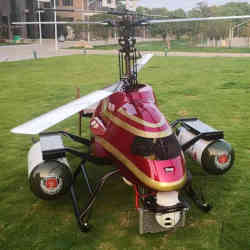
Disturbing images of communities and forests burning increasingly fill our newsfeeds and TV screens. According to analysis by the World Health Organization (WHO), wildfires have impacted millions of people globally. Countless insects, birds, and animals have also been displaced or perished. Wildfires are hitting record levels of size and severity around the world.
The Congressional Research Service (CRS) reports that in 2020, in the U.S. alone, 58,950 wildfires burned over 10 million acres (about 4 million hectares) of land. In Russia, fires devastated more than 18.16 million hectares (nearly 45 million acres) of forest in 2021, predominantly in Siberia. The Washington Post reported these fires were larger than the rest of the world's blazes combined. Similar record-breaking reports come from countries such as Italy, Turkey, and Australia.
Factors like extreme heat, drought, and climate change are fueling the flames. According to a review of 57 scientific articles carried out by ScienceBrief, an online platform that hosts expert-led analyses of consensus and controversies using peer-reviewed publications, "Human-induced climate change promotes the conditions on which wildfires depend, enhancing their likelihood and challenging suppression efforts."
In the face of this, global technologists are collaborating with fire professionals to build artificial intelligence (AI) and data-based solutions for fire detection, response, and recovery.
Fire data for knowledge and modelling
It is perhaps not surprising that wildfire-impacted California is ahead of the curve. The University of California San Diego-based WIFIRE Lab is a collaboration between data and AI researchers, private companies, and public agencies such as fire departments.
"Our mission is to turn data, artificial intelligence, and computing, these three things, into a utility for anyone in this domain," said Ilkay Altintas, chief data science officer at the San Diego Supercomputer Center (SDSC) and founder of the WIFIRE Lab.
The WIFIRE Lab builds AI and data-based platforms and products that have practical applications in fire science. Projects include WIFIRE Commons, a data and modelling environment; FireMap, a tool that creates predictive maps to show wildfires' expected trajectories, and BURNPRO 3D, an in-development prescribed—or controlled— burn simulation tool.
Thanks to its existing monitoring networks, San Diego is rich in fire data. WIFIRE Common's aim is to store and federate that data, which comes from multiple sources: cameras, satellites, Light Detection and Ranging (LiDAR) sensors, drones, and aircraft, and via multiple organizations, including national agencies, fire departments, aviation companies, and utilities.
Once the data has been collected, it must be made useful to researchers and fire professionals via modelling and visualization interfaces. AI is initially deployed "to fuse the data that we receive from different sources and bring it to a form the downstream fire models can accept," said Altintas, for example, through extrapolation or by making it higher or lower resolution.
There is also a semantic component to the work. The WIFIRE team built a fire science ontology on top of the existing environmental ontology. Said Altintas, "We specialize that to our domain so that data sets that we federate or store are tagged with those terms as well as the models."
WIFIRE Commons' modelling tools exploit the SDSC's supercomputing capabilities. Data is integrated with physics-based machine learning within the platform's models to predict, map, and visualize fire behavior. The QUIC-Fire model, for example, is a fast-running simulation tool that captures the interactions between fire, dynamic atmosphere, vegetation structure, and topography.
Like QUIC-Fire, FireMap is deployed in real-life scenarios by fire fighters and first responders, such as the Los Angeles Fire Department. The operational AI-based tool uses visualization techniques for prediction. "In a matter of minutes, someone with the knowledge can create a fire model about where the fire will go over the next couple of hours, so it gets used in initial attack," said Altintas.
While FireMap is responsive, the lab's latest product, BURNPRO 3D — an in-development AI tool funded by the National Science Foundation (NSF)— is proactive. It is designed to support land managers in planning and running prescribed burns— initiated to reduce an area's flammable material as part of the effort to combat megafires.
Altintas envisages a future where "every fire-useful data set" is part of WIFIRE Commons and can be combined with AI techniques to make it more accessible, scientific, and useful. The aim is to "transform data into forms that others can benefit from, and all of this community-driven, because you need more than a village to solve this problem," she said.
Ambitious collaborations between AI researchers and on-the-ground agencies underpin other wildfire solutions in the U.S. For example, ALERTWildfire, a partnership between the University of Nevada, University of California San Diego, and the University of Oregon, and such bodies as the Nevada Seismological Laboratory and utility Pacific Gas and Electric, uses Pan-Tilt-Zoom (PTZ) fire cameras and AI tools to support wildfire discovery, monitoring, and evacuation.
As wildfires burn across the planet, efforts to limit their devastating impact have also become global in scale.
Building big data for southern hemisphere recovery
Eyes on Recovery is a large-scale data and AI project led by the World Wide Fund for Nature (WWF) Australia and supported by Google AI. Its mission is to measure the impact of the 2019-20 summer bushfires (as wildfires are known in Australia) on wildlife and to support responses to future fires.
Emma Spencer is Eyes on Recovery's on-ground project coordinator. She is based in the Blue Mountains at the edge of the 2019-20 Gospers Mountain fire, one of the biggest fires in Australian history (it burned around one million hectares/nearly 2.5 million acres).
During the 2019-20 bushfire season, there were over 15,000 fires in Australia, killing or displacing around three billion creatures according to WWF Australia, said Spencer. "We're talking millions and millions of mammals and billions of reptiles, millions of birds, millions of frogs."
WWF Australia looked to its existing nationwide network of over 600 motion and thermal sensors and cameras for solutions. The network will allow them to monitor the impact of fires on wildlife and to develop strategies to support their recovery. However, with no means of managing the massive volumes of data, the team turned to AI.
In 2020, WWF Australia set up a collaboration with Conservation International and Google in the U.S., and on-the-ground partners like national parks, council groups, traditional owners, aboriginal groups, and universities to take on the challenge.
The sensor and camera data are collected by local partners on SD cards, although Spencer pointed out that future options may include using cameras that can transfer information over mobile broadband. The data is uploaded to Wildlife Insights, an online platform based on the open-source Google TensorFlow framework, where it is used for identifying, sharing, and analyzing wildlife data.
Blank images and false triggers in the data, like a blade of grass moving in the wind, are filtered out, and species depicted are identified. This information is the key to Eyes on Recovery, as it will allow scientists to analyze species numbers and distribution and to monitor recovery after wildfires.
Species classification is carried out via convolutional neural networks (CNN). "The idea is that they use these networks to pick out patterns and make sense of them," said Spencer.
Each convolutional layer filters for a particular criteria or feature. Initially they are broad, such as picking out edges, shapes, or textures, she explained. "Once it goes through several convolutions, it will end up looking more at something like more complex patterns. Does it have feathers? Where are the eyes? What is the shape around the eyes?"
Species identification is further enhanced by Integrated Gradients (IG), an AI attribution method that can be used in image classification to support model predictions via techniques such as decision-making based on a specific feature's importance.
Despite the fact that Wildlife Insights already contains over 12 million images of more than 890 species. Eyes on Recovery exposed a data gap, said Spencer. "Originally this AI has not been trained off Australian species, so it's quite amusing when we first were feeding images in, and wombats were coming up as pigs."
The Eyes on Recovery team are using existing datasets of southern hemisphere fauna to train Wildlife Insights' models to work in the Australian environment, where more than 80% of animals, reptiles, and frogs are unique. It is a mammoth task. "In an image, a kangaroo might just be a tail as that kangaroo hops across the frame, so that's why we need to build up these really complex image training datasets," said Spencer.
The team now is focusing on tasks such as cleaning and tagging data, and training the models. However, some monitoring results are already coming in. On Kangaroo Island, a mouse-like marsupial, the dunnart, lost 95% of its known habitat in the 2019-20 bushfires. "At almost all of the sites, the cameras we put out have detected dunnarts. It's providing a bit of hope as it's suggesting that species like these dunnarts might be recovering well in post-fire environments," said Spencer.
What WWF Australia is doing is not just about Eyes on Recovery, she added. "It's developing frameworks and technology that can be used across multiple locations, multiple fires, multiple times."
Wildfires are devastating communities and wildlife from San Diego and Siberia to the Blue Mountains of Australia. While nature is a force to be reckoned with and human activity is contributing to its destructive power, AI may help to manage it.
Karen Emslie is a location-independent freelance journalist and essayist.


Join the Discussion (0)
Become a Member or Sign In to Post a Comment